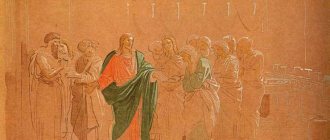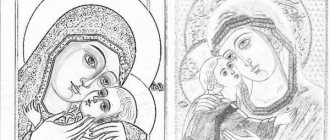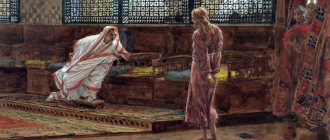Jesus or Jesus: the letter of schism
Estimated reading time: less than a minute.
Sometimes just one letter in a word, a dispute about whether to put it in it or not, can cause very deep discord. Of course, the word itself must be very important for this, have exceptional meaning.
Until the middle of the 17th century, our ancestors pronounced the first part of the name of the Lord Jesus Christ as “Isus” and wrote it as “Isus”.
Yuri Pushchaev
We have already written in the Explanatory Dictionary “Christ: the Anointed One” that recorded in ancient Greek transcription as ὁ Ἰησοῦς (Iisus) is a name of Jewish origin. It goes back to the verb “to save” and means “Savior” in Hebrew. In the Russian language, the first two sounds “and” of the name of the Lord and, accordingly, the first two letters merged into one. So the Greeks and Russians began to write and pronounce the name of Jesus Christ in different ways.
In the middle of the 17th century, Patriarch Nikon began a church reform, notorious for its consequences , which caused a deep split in the Russian Church and society. Nikon decided to change some of the liturgical rituals that had developed by that time, as well as correct some liturgical texts in order to bring them into line with the Greek ones.
Muscovite Rus', after the capture of Constantinople by the Turks (1453) and the fall of Byzantium, remaining the only Orthodox country in the world, began to think of itself as a stronghold, as the only and last defense of Ecumenical Orthodoxy. This is where the famous idea of the “Third Rome” was born: the first two have fallen, the third stands, but the fourth will not exist. It is believed that Patriarch Nikon intended to create an Ecumenical Orthodox Kingdom centered in Moscow and occupy a dominant position among the Orthodox patriarchs. To do this, it was necessary to become equal to the Greeks in ritual and rank.
Among the main innovations were the introduction of the three-finger sign of the cross, not the two-finger one, the triple sign of the cross, not the double sign (double “Alleluia”), the procession of the cross around the church “anti-salt” - against the sun, that is, from west to east, and not vice versa, etc. .d. In particular, another letter was added to the name “Jesus” (under the title “Ic”), and it began to be written “Iesus” (under the title “Iis”).
Dual fingers. Lubok of the 17th century. Fragment
Reforms were carried out very hastily, using violent methods. This caused the rejection of many clergy and laity and, as a result, caused a schism in the Russian Orthodox Church, the consequences of which have not yet been overcome. The Old Believers were anathematized by the church; for almost two and a half centuries they were persecuted and their rights were limited in every possible way.
Only in 1971, the Local Council of the Russian Orthodox Church finally confirmed the recognition of the old Russian rites as saving and equal to the new ones and abolished the anathematization of everyone who adheres to them: “The consecrated local council of the Russian Orthodox Church embraces with love all who sacredly preserve the ancient Russian rites, as members of our holy Church, and those who call themselves Old Believers, but who sacredly profess the saving Orthodox faith. The consecrated local council of the Russian Orthodox Church testifies that the salvific significance of the rites does not contradict the diversity of their external expression, which was always inherent in the ancient undivided Church of Christ and which was not a stumbling block and a source of division in it.”
On the good side, both sides were to blame for the schism of the mid-17th century, each in its own way distinguished by intolerance and deafness. If the “Nikonians,” as the Old Believers say, are reproached for a punitive policy carried out with the help of the state, then the Old Believers are usually blamed for their “ritual faith” and blind adherence to the letter. After all, the Apostle Paul said: “The letter kills, but the Spirit gives life” (2 Cor 3:6).
Metropolitan of Krutitsky and Kolomna JUVENALIY (Poyarkov) leads the service in the Edinoverie Church in the name of Arch. Mikhail in the village Mikhailovskaya Sloboda. 2007 Photo: PEnz
These words are often quoted in support of the idea that the Old Believers seemed to be stuck in the 17th century, “clinging” to things that were of little significance from the point of view of the essence of faith. In the end, different Local Orthodox Churches differ from each other in some rituals, but this does not prevent them from considering themselves parts of a single Orthodox Church.
Meanwhile, it is interesting to note that the Apostle Paul does not at all condemn the service of the letter as such and does not at all contrast the letter with the spirit. Indeed, in the next verse of this Epistle he says that “the service of the deadly letters written on the stones was so glorious that the children of Israel could not look upon the face of Moses because of the glory of his face that was passing away” (2 Cor 3:7). That is, he calls the service of the “mortal letters” so glorious that the Jews could not even look at the light-emanating face of Moses when he brought them the tablets of the Covenant.
Yes, the apostle goes on to say that the ministry of the spirit is much more glorious than the ministry of “deadly letters.” But service to the letter is also glorious, albeit to a lesser extent. This is like a necessary preliminary stage - in order to gloriously serve the spirit, you first need to kill yourself with the letter and serve it. So in fairy tales, a good young man is first doused with dead water, and then resurrected with living water.
The meaning of some biblical names
In general, God often put meaning into the names given to people in the Bible. In the book of Hosea, for example, we can see that God asks Hosea to name his children Loruhama, which means “she who has not obtained mercy,” and Loammi, which means “not my people.” God told Hosea to marry a harlot and call the children “she who has not obtained mercy” and “not my people” to show that God has something against His chosen people. There is a lot of meaning in these actions and names.
When God decided to fulfill His mission through Abram, He gave him a new name. He named him Abraham (with two "a's"). His new name now meant “father of many nations.”
“This is My part of the agreement: I will make you the father of many nations. I will change your name: your name will not be Abram, but Abraham, for I will make you the father of many nations. I will give you a great reward—new nations will come from you and kings will arise” (Genesis 17:4-6).
Origin of the name
The name of Jesus Christ comes from the combination of two languages. The second part of the name - “Christ” - is translated from ancient Greek as “Anointed One,” that is, the mediator between God and humanity in the Jewish tradition. The first part “Jesus” is a modern Church Slavonic transliteration of the Greek form of the Hebrew name “Yeshua”, the truncated “Yehoshua”, which comes from the merger of the name of the Old Testament God Jehovah with the root “shua” (“save”) and is translated from Hebrew as “Savior” " In the Russian language, until the middle of the 17th century, the first two sounds “and” in the name “Jesus” merged into one and, accordingly, unlike the Greek version, the name was written truncated: “Isus”.
Savior in the history of the world
At first
God the Son is coeternal with God the Father and God the Holy Spirit, and exists originally, before the creation of time. At the eternal council of the Most Holy Trinity, when drawing up a plan for the creation and salvation of mankind, He agreed to undertake the incarnation and redemptive feat (Heb. 10:5-7; Eph. 1:4; 1 Pet. 1:20). At the creation of the world, everything that exists was created by the One God the Creator, the Most Holy Trinity, and the Father acted through the Son in the Spirit. Therefore, it is said about Christ that “all things came into being through Him” (John 1:3), “all things were created by Him and for Him” (Col. 1:16).
Old Testament era
After the fall of the first people, Adam and Eve, the human race was damaged by evil - that is, subject to sin, curse and death - and could not correct itself. Then God made the Old Testament with people, promising to give them a Savior. This promise was first given in paradise, and in the name of Christ “The Seed of the Woman” there was a revelation about His seedless conception by the Ever-Virgin Mary (Gen. 3:15). The entire subsequent Old Testament era became a time of preparation for humanity to accept the coming Christ. The people of God, who kept faith in the coming Messiah, formed the Old Testament Church.
Through gradual revelations, prophecies and types, God repeated His promise to people and gave signs by which they could recognize the Savior. Thus, the promise of the Savior was repeated to the forefather Abraham (Gen. 22:18) and King David (2 Sam. 7:12-13) - the ancestors of Christ according to the flesh. Among the numerous Old Testament prophecies about Christ, the clearest and most detailed were given through the prophets David and Isaiah, which is why the Psalter remains the most used in the worship of the Church, and Isaiah is called the “Old Testament Evangelist.” The prototypes of Christ were both people - such as the priest-king Melchizedek, Patriarch Joseph the Beautiful, the prophet Moses the Seer of God and the long-suffering righteous Job - and creatures and objects, starting with the Passover lamb, manna from heaven and the copper serpent. Finally, people of the Old Testament era were repeatedly rewarded with Epiphanies (theophanies), in which God appeared to the world in various guises - most often in the form of an angel or a husband. It is God the Son in the Divine Economy who is the God of Revelation, therefore all the Old Testament appearances of God were phenomena of the Second Hypostasis.
Thanks to God's Providence, saving faith in the coming Savior was invariably preserved among the Jews. However, before the coming of Christ, the law of sin continued to operate, according to which people were unable to accept the gifts of God’s regenerating grace and invariably fell into death after death.
| Crucifixion of the Lord. Icon 1st half. XIV century, Constantinople. Collection Byzantine and Christian Museum of Athens |
First Coming
The Old Testament period of world history ended when the promised Christ the Savior was finally sent by the Father, “came down from heaven” (John 3:13) and came to earth as a man. The purpose of this First Coming of Christ was to save humanity from sin, damnation and death. For this, the Son of God became incarnate from the Holy Spirit and the Ever-Virgin Mary, and became human - that is, he took on a human body and soul. Having united in Himself the natures of God and humanity, the God-man Jesus Christ became the New Adam - the ancestor of a new, deified humanity. His birth according to the flesh took place around 5 BC. e., during the reign of Emperor Octavian Augustus, in Judea conquered by the Romans, in the city of Bethlehem, in a cave intended for cattle stalls. Thus, Jesus Christ “made Himself of no reputation, taking the form of a servant” (Phil. 2:7).
When the Lord Jesus reached the age of 30, he began to teach. The content of His sermon was “The Gospel of the Kingdom of God” (Mark 1:14) - that is, the doctrine of salvation and blessedness. The most important instructions of Christ are concentrated in His Sermon on the Mount (Matthew 5-7). Having chosen his closest disciples - the apostles - He fully showed them the revelation of God by His word and example. To reassure people, the Savior performed many miracles—turned water into wine; healed the sick, crippled and possessed; fed thousands of people with a few loaves of bread; walked on water; with a word he tamed the storm; raised the dead. The Lord exposed the false teaching and lawless life of many leaders of the Jewish people. Having found faith in the disciples and glory among the people, He aroused the envy and hatred of other elders and scribes.
In the third year of His public ministry, just before Easter, the Lord Jesus Christ was betrayed, condemned, mocked, crucified on the Cross and buried outside the walls of Jerusalem. The Savior voluntarily gave Himself to suffering and death. According to His word: “I lay down My life in order to take it up again. No one will take it away from Me; but I myself give it away” (John 10:17-18). By sacrificing Himself for all people, He redeemed humanity and delivered it from the consequences of the Fall. “The chastisement of our peace was upon Him, and by His stripes we were healed” (Isa. 53:5).
Death according to humanity could not kill the Divine. While His body rested in the tomb, the Savior descended in soul to bind the devil there, preach victory over death and lead the souls of the righteous who were waiting for Him to heaven. On the third day, the Lord Jesus Christ was resurrected in an immortal body, becoming “the firstborn of those who died” (1 Cor. 15:20). For forty days He appeared to the apostles, continuing to teach them. Then He ascended into Heaven with His humanity and sat down at the right hand of the Father, so that His human soul and body received the same glory that Christ has in His Divinity. Thus, the Son of God achieved the salvation of people, deifying humanity in Himself and opening the way to the Kingdom of Heaven for all who unite with Him in His Church.
| Savior in hell. Fragment of the fresco “The Resurrection of Christ” (1316-1321). Altar of the Spassky Church of the Chora Monastery of Constantinople (Kariye Museum) |
New Testament era
The appearance and accomplishments of the Divine Savior Jesus Christ established the New Covenant of God with people, according to which humanity is called to live until the Second Coming of Christ. Having ascended into heaven, the Lord did not leave His disciples, but promised to be with us “always, even to the end of the age” (Matthew 28:20). For all those who believe and those who follow Him, He established the New Testament Church, the formation of which was completed by the sending of the Holy Spirit from the Father to the apostles on the tenth day after the Ascension. As the Head, Foundation and Bridegroom of the Church (Eph. 1:22, 1 Cor. 3:11, Eph. 5:22-32), the Lord illuminates, governs, teaches and works savingly in it with His grace. In the sacrament of Communion established by Christ - the core of New Testament worship - He is both the High Priest and the Lamb, “bringing, and offered, and received, and distributed” to introduce the faithful to eternal life. This is how His words are fulfilled again and again: “He who eats My flesh and drinks My blood has eternal life” (John 6:54). The Lord also acts through other sacraments, listens to prayers, has a special presence in the temples of God and in every gathering of people in His name (Matthew 18:20). Finally, He appears to people in a visible way, as was the case with the first martyr Stephen (Acts 7:55-56) and with many saints to this day.
As the omnipresent God the Word, the Lord still provides for the whole world. He carries out private judgment on the soul of each person after his death. Having a special presence in heaven, in eternal glory, He reveals himself to the souls of the righteous: their posthumous bliss is connected with the sight of Jesus Christ. But the Lord will carry out His final judgment on everyone only at the end of this world.
| Savior Not Made by Hands. Icon of the 12th century, Novgorod. Collection Tretyakov Gallery |
Second coming
The second coming of Christ will mark the “end of the age” - the end of the history of the world as we know it. “The times or seasons” (Acts 1:7) of this event are hidden from people, but some signs of its approach are open: a decrease in faith and love between people, an increase in vices and disasters, preaching the Gospel to all nations, the conversion of the Jews to Christ, the coming of the Antichrist ( Matthew 24;Rom 11:25-32). However, despite the known signs, the “day of the Lord” threatens to come “like a thief in the night” (2 Pet. 3:10), which is why the Son of God called the faithful to constant vigilance. The final destinies of the world are described in the most detail, but also most mysteriously, in the Revelation of John the Theologian.
The purpose of the Second Coming of Christ will be judgment and reign over the world. The Lord Jesus will come the second time in the same way as He previously ascended into heaven (Acts 1:11). If the first time He came in humiliation, now He will come in glory, with an army of angels (Matthew 25:31); if for the first time he became like the Lamb, now he will also become like the Lion. Having crushed the Antichrist, He will sit as King and Judge at the Last Judgment. Then the dead will rise, all humanity will gather before Him and everyone’s conscience will be opened. Without partiality, the Lord will divide humanity into “sheep” and “goats”: the first will go into eternal life, and the second into eternal punishment (Matthew 25:31-46, John 5:28-29, 1 Cor. 4:5) .
After the Last Judgment, eternal life will begin in the Kingdom of Christ, which will never end (Luke 1:33).
What was another name for Jesus Christ?
Jesus Christ lived a short life, but with his good deeds he managed to gain popularity among ordinary people. At the same time, other names for his person began to spread.
Son of Man
One of the most popular is the Son of Man. This designation is found in the Gospels and has a specific meaning. Jesus does not magnify His divine power, does not reveal it to the people at the first whim. In this sense, He behaves like the Son of Man - born in the Earthly Kingdom, indistinguishable from other people. The Lord, who chose flesh, decided to become closer to people, which is why he is called that way.
God's Son
Christ was also called the Son of God. Here the situation is somewhat different than in the first case. Not only Jesus himself called himself the Son of God, but also those who recognized His holiness above earthly riches. The designation presented identifies Him with the Lord, which makes the concepts “Lord” and “Son of God” synonymous.
Son of David
Christ is also called the Son of David. Traditionally, messiahs came from the line of David, and David himself received divine Revelation. Thus, the Almighty introduces His Son to the human world, recognizing Him as Revelation in the flesh.









